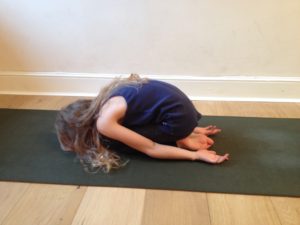Sensory Processing Difficulties: Walking on bubble wrap
Mel Campbell, Occupational Therapist, Advanced Sensory Integration Practitioner and Yoga Teacher explores mindfulness and Sensory Processing Difficulties: walking on bubble wrap.
This exercise can help children and young adults with poor grading of movement.
It supports them to gain an awareness of the amount of force they apply, and what adjustments to make, when using motor skills.
It’s a fun exercise too!
Child’s Pose Sensory Benefits
Well, winter is well and truly on its way now. The leaves are shredding their leaves and nature is getting ready for the big sleep. Our clocks’ have gone back an hour, the nights are getting darker and we ourselves may feel like hibernating. Our energy may feel more grounded and we may find ourselves being more reflective and wrapped up in our own thoughts, so we can retreat and gather our energy inwards in readiness for blossoming again in spring.
For children with sensory processing difficulties this shift in energy maybe difficult for them. The weather is colder, yet they may not have the sensory feedback or awareness of needing to wrap themselves up in extra layers or may be over sensitive to the feel of extra clothing on their skin, refusing to go out.
Child’s pose – Come to sit on your heels and curl back into a ball with your bottom resting on your heels and your head resting down towards the floor. If your head doesn’t reach the floor – that’s fine – make a bridge with your fists. Rest here for between 5-10 breaths. Notice your breath. Feel your breath coming in through your nose and out again. Can you feel your breath coming into the middle of your chest? Maybe you would like to imagine you are an animal maybe a hedgehog or a field mouse, retreating, hibernating, being quiet, still and contented.
Sensory tips:
Proprioception/ Body awareness: Notice how it feels with your bottom resting on your heels and your head resting. Are your hands and fingers relaxed? Can you relax the expression on your face?
Vestibular: Having your head bowed down and curled in stimulates the vestibular sensory system and is calming for the arousal levels.
Tactile: The deep pressure of being huddled tight in this pose offers deep pressure which is calming for the nervous system
Mindfulness:
Gather a selection of autumn leaves and conkers – compare the textures of the crisp, rough leaves to the smoothness of the conker.
The heaviness of the conker compared to the lightness of the leaves.
The noise of the leaves rustling against each other compared to the hardness of the conkers knocking against each other
Notice the different colours, textures, smells.
Yoga for Sensory Processing Disorders
Yoga for Sensory Processing Disorders is a wonderful way to help bring individuals’ back into their bodies and helps them learn to breathe, regulating their arousal levels and allows their central nervous systems to relax.
Sensory Processing Disorder is a condition that exists when sensory signals don’t get organized into appropriate responses and an individual may exhibit clumsiness, poor motor skills and behaviour difficulties as a result of their sensory systems becoming over responsive to sensory input or under responsive so they want to seek out more.
Yoga for Sensory Processing Disorders supports body awareness, movement and self-regulation through the mind, body and breath helping individuals with dyspraxia, postural instability and sensory modulation difficulties.
Mel Campbell is an occupational therapist and yoga teacher and an advanced sensory integration practitioner who has worked extensively with children and young people with Sensory Processing Difficulties. She has created a Sensory Processing Yoga DVD which features four easy to follow yoga classes; Alerting, Calming, Motor Planning and Postural Stability as well as various Breathing Exercises and a Guided Relaxation. The DVD is available to buy here.
If you would like to subscribe to more information about Sensory Processing Yoga click here.


